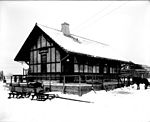Checkerboard Inn

The Checkerboard Inn, also known as the Forshee-Jenkins House, is a late 18th-century frame building located on Mansion Ridge Golf Club in Monroe, New York, United States. Originally built as a house, within a decade it went into service as an inn when the Orange Turnpike, an early toll road through the area, opened in 1802. It takes its name from an early owner's reputed decision to paint it in a checkerboard pattern to attract business, although this has not been conclusively established. In the 20th century, it was expanded to serve as a family cottage for the family of a New York silk merchant, Moses Migel. Today, after many other owners and a long period of neglect, it remains standing, vacant, next to the golf course's clubhouse. It is the property of the Town of Monroe, and was listed on the National Register of Historic Places in 2006. The town is hoping to raise the money to restore it and use it as a local history museum.
Excerpt from the Wikipedia article Checkerboard Inn (License: CC BY-SA 3.0, Authors, Images).Checkerboard Inn
Orange Turnpike,
Geographical coordinates (GPS) Address Nearby Places Show on map
Geographical coordinates (GPS)
| Latitude | Longitude |
|---|---|
| N 41.300555555556 ° | E -74.183611111111 ° |
Address
Orange Turnpike 1292
10950
New York, United States
Open on Google Maps









